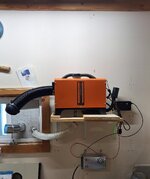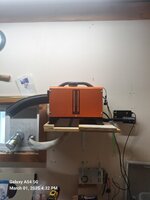Dalecamino
Local Chapter Leader
We'll soon find out. When my electric bill more than doubled last month, I decided to shop for an alternative way to heat the shed. I found this Vevor diesel heater while browsing Youtube. After watching hours of videos, I decided to buy one. I learned that the factory fuel pumps are quite loud as they have a piston inside of them that slides back and forth. I knew I couldn't stand that for very long, so I searched for ways to make them quieter. That search lead me to a gentleman in the UK who builds silent fuel pumps. That would be the black box on the wall to the right of the heater in the photo.
The heater is powered by 12 volt battery. I wanted to be able to plug it into a 110v outlet, so I bought a 110 to 12v converter. The heater has a cool down feature, which means they have to cool down after you turn them off. They still need power during this stage. So, battery back up is needed. The power supply (silver box under the heater in the photo) will automatically switch from 110v to 12v instantly. This prevents damage to the heater. On start up, the heater can pull 10 amps for a few minutes, then drops to around 2 amps. Fuel capacity is 1.3 gallons, or 5 liters. At 120 square feet, I can run the heater on lowest setting after initial warm up. Expectation is 30 + hours on a gallon of fuel. I bought 2 gallons of diesel fuel at $3.49 per gallon.
Exhaust / intake
The heater has an intake (Inlet for the turbo fan) and an exhaust (outlet for the turbo) There is a fan in front of the turbo for air to pass over the turbo housing where the heat comes from. There is an exhaust pipe for the fumes to be expelled. I've run the exhaust out the window through a piece of backer board. This exhaust pipe gets extremely hot. I lined the hole for the pipe with aluminum tape. I'll have to keep an eye on that. I don't believe the board will burn, but still want to be cautious. On the board there is a 3" hole for the exhaust from the laser engraver. I stuck a 3" elbow in there to connect the hose to. I set this up so I can remove the board, and set it on the bench when I'm finished, then close the window.
Tuning
I still need to tune the silent pump when I start it up. I'll need to adjust the 12 volt power output on the converter, and adjust the air/fuel mixture on the pump for my altitude. I'll acquire my brother's assistance for this step.
I hope this works out! Stay tuned for updates!
The heater is powered by 12 volt battery. I wanted to be able to plug it into a 110v outlet, so I bought a 110 to 12v converter. The heater has a cool down feature, which means they have to cool down after you turn them off. They still need power during this stage. So, battery back up is needed. The power supply (silver box under the heater in the photo) will automatically switch from 110v to 12v instantly. This prevents damage to the heater. On start up, the heater can pull 10 amps for a few minutes, then drops to around 2 amps. Fuel capacity is 1.3 gallons, or 5 liters. At 120 square feet, I can run the heater on lowest setting after initial warm up. Expectation is 30 + hours on a gallon of fuel. I bought 2 gallons of diesel fuel at $3.49 per gallon.
Exhaust / intake
The heater has an intake (Inlet for the turbo fan) and an exhaust (outlet for the turbo) There is a fan in front of the turbo for air to pass over the turbo housing where the heat comes from. There is an exhaust pipe for the fumes to be expelled. I've run the exhaust out the window through a piece of backer board. This exhaust pipe gets extremely hot. I lined the hole for the pipe with aluminum tape. I'll have to keep an eye on that. I don't believe the board will burn, but still want to be cautious. On the board there is a 3" hole for the exhaust from the laser engraver. I stuck a 3" elbow in there to connect the hose to. I set this up so I can remove the board, and set it on the bench when I'm finished, then close the window.
Tuning
I still need to tune the silent pump when I start it up. I'll need to adjust the 12 volt power output on the converter, and adjust the air/fuel mixture on the pump for my altitude. I'll acquire my brother's assistance for this step.
I hope this works out! Stay tuned for updates!


